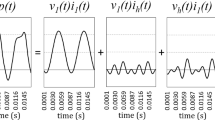Contents
This paper analyzes a problem of phase shifting and deseribes a novel method for electronic reactive energy measurement. The proposed measurement structure, composed of an integrator as a phase shifting circuit and a frequency controlled analog-to-pulse-rate converter, provides for the measurement completely in accordance with IEC definition of reactive energy, which is performed with simple but high performance metering device.
Übersicht
In diesem Artikel wird das Problem der Phasenverschiebung analysiert und eine neue Meßmethode für elektronische Blindverbrauschsmessung aufgezeigt. Die vorgeschlagene Strucktur, bestehend aus einem Integrator als Phasenschieber und netzkontrolliertem Analog-Frequenz-Wandler, ermöglicht die Verwirklichung eines einfachen aber präzisen Elektrizitätszählers zur Messung der Blindenergie, dessen Arbeitsprinzip mit den IEC Empfehlungen vollkommen übereinstimmt.
Similar content being viewed by others
References
Czarnecki, L. S.: What is Wrong with the Budeanu Concept of Reactive and Distortion Power and Why It Should be Abandoned. IEEE Trans. Instrum. Meas. 36 (1987) 834–837
Var-hour (Reactive Energy) Meters. IEC Publication 145 (1963)
Tschappu, F.: Untersuchungen über den Einfluß von unsymmetrischen Netzspannungen auf die Meß- und Prüfschaltungen der Drehstrom-Elektrizitätszähler. Landys & Gyr Mitteilungen 23 (1976) 2–11
Siebert, W. McC.: Circuits, Signals, and Systems. Cambridge, London: The MIT Press 1986
Bedrosian, S. D.: Normalized Design of 90° Phase-Difference Networks. IRE Trans. Circuit Theory 7 (1960) 128–136
Dehmel, G., Lukoschus, D.: Phase Shifter With High Amplitude Accuracy. Electronics Letters 10 (1974) 22–23
Chambers, R. G.: Unity-Gain Frequency-independent precision phase-shifter. Electronics Letters 20 (1984) 151–152
Static watt-hour meters. Metrological specifications for Classes 0.2 S and 0.5 S, IEC Report, Publication 687 (1980)
Kalinski, J.: Variable FET resistance gives 90° phase shifts. Electronics, July 20 (1970) 80
Statische Präzisionszähler Z. T. Landis & Gyr, Technische Daten, F22
Rügger, M.: Statischer Eichzähler TVH2 für Wirk- und Blindverbrauchsmessung. Landis & Gyr Mitteilungen, No. 2 (1979)
Petry, P. P.: Quadrature phase shifter for nonsinusoidal. Electronic Engineering April (1984) 32
Tay, E. W.; Murti, V. G. K.: Unity-Gain Frequency-independent Quadrature Phase Shifter. Electronics Letters 20 (1984) 151
Wilson, G.: Precision RC-Active Frequency Compensated Phase Shifters. IEE Proc. 137 (1990) 44–48
Bombi, F., Lange, W., Seyfried, P.: Elektronischer Leistungsfrequenzwandler für Elektrizitätszähler hoher Präzision. Meßtechnik 10 (1971) 223–227
(Friedl, R.; Lange, W.; Seyfried, P.: Electronic Three-Phase Four-Wire Power-Frequency Converter With High Accuracy Over a Wide Range of Use. IEEE Trans. Instrum. Meas. 20 (1971) 308–312)
Schwendtner, M.; Steinmüller, G.: Elektronischer kWh-Zähler hoher Genauigkeit. Siemens-Zeitschrift 10 (1971) 671–675
Vonarburg, H.; de Vries, J. H.: Elektronischer Elektrizitätszähler hoher Präzision, Meßtechnik 10 (1971)
Kime, R. C.; Kusterer, V.: “Charge balancing” — ein neues A/D Integrationsverfahren. Elektronik 12 (1974) 469–472
Goldberg, E.: A high-accuracy time-division multiplier. RCA Review, September (1952)
Kusui, S.; Yamazaki, N.: Household watthour meter with hybrid ICs and progress of static watthour meter in Japan, IEE MATES Conference Publication 156 (1977)
Miljanić, P.; Stoljanović, B.; Bošnjaković, P.: The development of a high precision time-division power meter. 14th Conference on Precision Electromagnetic Measurements, Delft, Proc. CPEM'84 (1984) 67–68
Bošnjaković, P.; Stojanović, B.; Miljanić, P.: A new approach to electrical energy measurement. 14th Conference on Precision electromageetic Measurements, Delft, Proc. CPEM'84 (1984) 63–64
Bošnajković, P. M.; Djokić, B. V.; Stojanović, B. M.: High performance electronic instrument for electrical power and energy measurement. IEE MATES Conf. Publication No. 277, Paper no 6.3, (1987) 153–156
Bergeest, R.; Seyfried, P.: Evaluation of the response of time-division multipliers to AC and DC input signals. IEEE Trans. Instrum. Meas. 24 (1976) 296–299
Stabrowski, M. M.: Modern numerical analysis of time-division multipliers. IEEE Trans. Instrum. Meas. 28 (1979) 74–78
Filipski, P. S.: The systematic errors of a time-division power converter under sinusoidal and nonsinusoidal conditions, IEEE Trans. Power Delivery 1 (1986) 61–67
Three-phase Reactive Energy Meters, Z23/E-CH506, Landis & Gyr, Switzerland
Author information
Authors and Affiliations
Rights and permissions
About this article
Cite this article
Bošnjakovié, P., Djokié, B. Reactive energy measurement using frequency controlled analog-to-pulse-rate converter. Archiv f. Elektrotechnik 75, 131–135 (1992). https://doi.org/10.1007/BF01577631
Received:
Issue Date:
DOI: https://doi.org/10.1007/BF01577631




